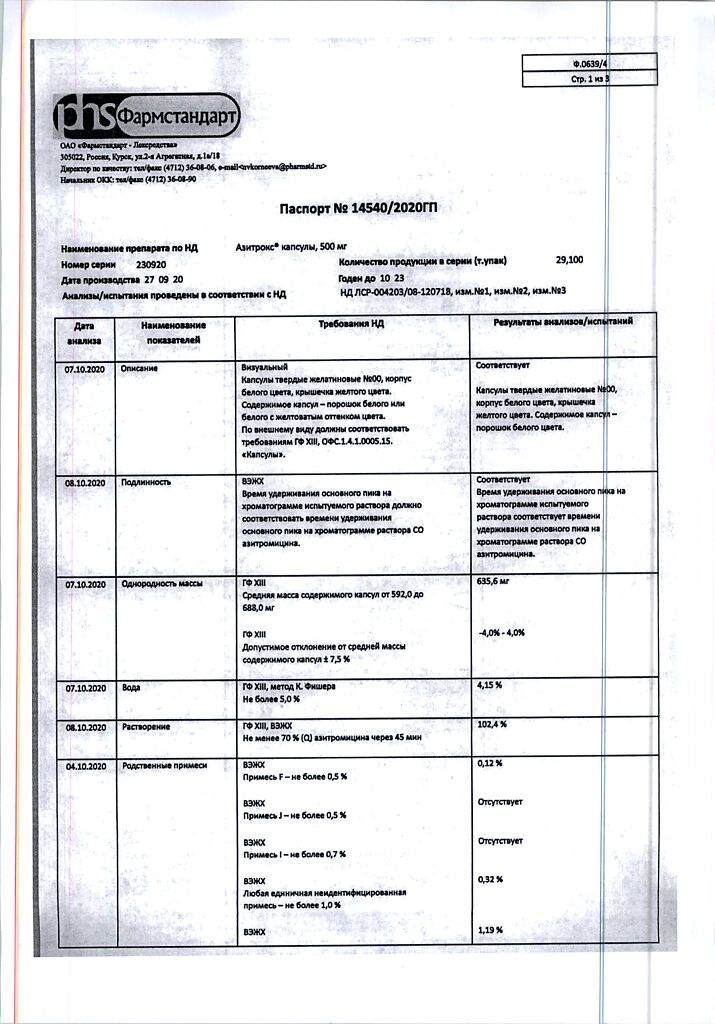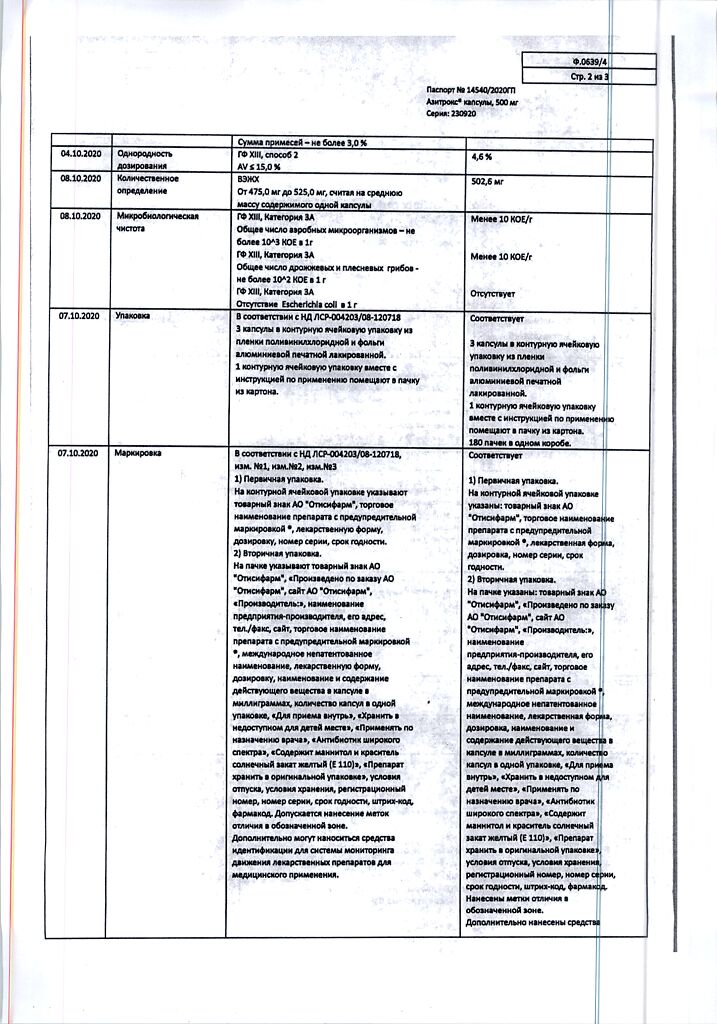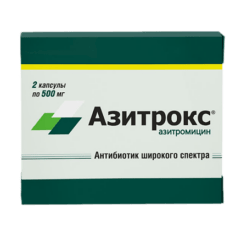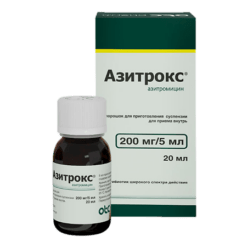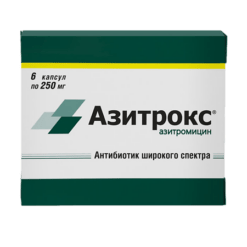No products in the cart.
Azitrox, 500 mg capsules 3 pcs
€10.12 €8.86
Description
Pharmacotherapeutic group: azalid antibiotic
ATX code: [J01FA10]
Pharmacological properties
Pharmacodynamics A broad spectrum antibiotic. It is a representative of the subgroup of macrolide antibiotics – azalides. Binding with 50S ribosome subunit it inhibits peptide translocation stage, inhibits protein synthesis, inhibits bacterial growth and reproduction, acts bacteriostatic, in high concentrations it has bactericidal effect. It acts on extra- and intracellular pathogens.
Active against Gram-positive aerobic microorganisms: Streptococcusspp. (groups A, B, C, G), Streptococcuspneumoniae (penicillin-sensitive), Streptococcuspyogenes, Staphylococcusaureus (methicillin-sensitive); Gram-negative aerobic microorganisms: Haemophilus influenzae, Haemophilus parainfluenzae, Moraxellacatarrhalis, Legionellapneumophila, Neisseriagonorrhoeae, Pasteurellamultocida; some anaerobic microorganisms: Prevotellaspp., Clostridiumperfringens, Fusobacteriumspp. , Porphyriomonasspp.; and Chlamydiatrachomatis, Chlamydiapneumoniae, Chlamydiapsittaci, Mycoplasmapneumoniae, Mycoplasmahominis, Borreliaburgdorferi.
Microorganisms capable of developing resistance to azithromycin: Gram-positive aerobes (Streptococcuspneumoniae (penicillin-resistant)).
Initially resistant microorganisms: Gram-positive aerobes (Enterococcusfaecalis, Staphylococcusspp. (methicillin-resistant Staphylococcus aureus shows a very high degree of resistance to macrolides), erythromycin-resistant gram-positive bacteria); anaerobes (Bacteroidesfragilis).
Pharmacokinetics
Azithromycin is rapidly absorbed from the gastrointestinal tract due to its stability in acidic environment and lipophilicity. After oral administration of 500 mg, maximum blood plasma concentration of azithromycin is reached after 2.5 – 3.0 hours and is 0.4 mg/l. Bioavailability is 37%.
Asithromycin penetrates well into the respiratory tract, organs and tissues of the urogenital tract (in particular the prostate gland), skin and soft tissues.
The high concentration in tissues (10-50 times higher than in blood plasma) and long half-life are due to low binding of azithromycin to plasma proteins and also to its ability to penetrate into eukaryotic cells and to concentrate in low pH environment surrounding lysosomes.
This, in turn, determines a large apparent volume of distribution (31.1 L/kg) and high plasma clearance. The ability of azithromycin to accumulate mainly in lysosomes is particularly important for the elimination of intracellular pathogens.
It is proved that phagocytes deliver azithromycin to sites of infection localization where it is released during phagocytosis. Concentration of azithromycin in the foci of infection is significantly higher than in healthy tissues (on average by 24-34%) and correlates with the degree of inflammatory edema.
Despite high concentration in phagocytes, azithromycin has no significant effect on their function. Azithromycin remains in bactericidal concentrations in the focus of inflammation for 5-7 days after the last dose, that allowed to develop short (3-day and 5-day) courses of treatment.
It is demethylated in the liver; the resulting metabolites are inactive.
The excretion of azithromycin from blood plasma occurs in 2 stages: half-life is 14-20 hours within the period from 8 to 24 hours after taking the drug and 41 hours within the period from 24 to 72 hours, allowing to use the drug once a day.
Azithromycin is excreted mainly unchanged – 50% by the intestine, 12% by the kidneys.
Indications
Indications
Infectious and inflammatory diseases caused by microorganisms sensitive to the drug:
infections of the upper respiratory tract and ENT organs (tonsillitis, sinusitis, tonsillitis, otitis media);
scarlet fever;
infections of the lower respiratory tract (bacterial and atypical pneumonia, bronchitis);
infections of the skin and soft tissues (erysipelas, impetigo, secondary infected dermatoses);
infections of the urogenital tract (uncomplicated urethritis and/or cervicitis);
Lyme disease (borreliosis) in the initial stage (erythema migrans);
diseases of the stomach and duodenum associated with Helicobacter pylori.
Pharmacological effect
Pharmacological effect
Pharmacotherapeutic group: antibiotic-azalide
ATX code: [J01FA10]
Pharmacological properties
Pharmacodynamics Broad-spectrum antibiotic. It is a representative of a subgroup of macrolide antibiotics – azalides. By binding to the 50S subunit of ribosomes, it inhibits peptide translocase at the translation stage, suppresses protein synthesis, slows down the growth and reproduction of bacteria, acts bacteriostatically, and has a bactericidal effect in high concentrations. Acts on extra- and intracellular pathogens.
Active against gram-positive aerobic microorganisms: Streptococcus spp. (groups A, B, C, G), Streptococcuspneumoniae (penicillin-sensitive), Streptococcuspyogenes, Staphylococcusaureus (methicillin-sensitive); gram-negative aerobic microorganisms: Haemophilus influenzae, Haemophilus parainfluenzae, Moraxellacatarrhalis, Legionellapneumophila, Neisseriagonorrhoeae, Pasteurellamultocida; some anaerobic microorganisms: Prevotellaspp., Clostridiumperfringens, Fusobacteriumspp., Porphyriomonasspp.; as well as Chlamydiatrachomatis, Chlamydiapneumoniae, Chlamydiapsittaci, Mycoplasmapneumoniae, Mycoplasmahominis, Borreliaburgdorferi.
Microorganisms that can develop resistance to azithromycin: gram-positive aerobes (Streptococcus pneumoniae (penicillin-resistant)).
Initially resistant microorganisms: gram-positive aerobes (Enterococcus faecalis, Staphylococcus spp. (methicillin-resistant staphylococci show a very high degree of resistance to macrolides), gram-positive bacteria resistant to erythromycin); anaerobes (Bacteroidesfragilis).
Pharmacokinetics
Azithromycin is rapidly absorbed from the gastrointestinal tract due to its stability in an acidic environment and lipophilicity. After oral administration of 500 mg, the maximum concentration of azithromycin in the blood plasma is reached after 2.5 – 3.0 hours and is 0.4 mg/l. Bioavailability is 37%.
Azithromycin penetrates well into the respiratory tract, organs and tissues of the urogenital tract (in particular the prostate gland), skin and soft tissues.
The high concentration in tissues (10-50 times higher than in plasma) and the long half-life are due to the low binding of azithromycin to plasma proteins, as well as its ability to penetrate eukaryotic cells and concentrate in the low pH environment surrounding lysosomes.
This, in turn, determines the large apparent volume of distribution (31.1 l/kg) and high plasma clearance. The ability of azithromycin to accumulate predominantly in lysosomes is especially important for the elimination of intracellular pathogens.
It has been proven that phagocytes deliver azithromycin to sites of infection, where it is released during the process of phagocytosis. The concentration of azithromycin in foci of infection is significantly higher than in healthy tissues (on average by 24-34%) and correlates with the degree of inflammatory edema.
Despite its high concentration in phagocytes, azithromycin does not have a significant effect on their function. Azithromycin remains in bactericidal concentrations at the site of inflammation for 5-7 days after taking the last dose, which made it possible to develop short (3-day and 5-day) courses of treatment.
It is demethylated in the liver, the resulting metabolites are not active.
The elimination of azithromycin from blood plasma occurs in 2 stages: the half-life is 14-20 hours in the range from 8 to 24 hours after taking the drug and 41 hours in the range from 24 to 72 hours, which allows the drug to be used once a day.
Azithromycin is excreted mainly unchanged – 50% by the intestines, 12% by the kidneys.
Special instructions
Special instructions
If you miss one dose of the drug, the missed dose should be taken as early as possible, and subsequent doses should be taken at intervals of 24 hours.
Azitrox® should be taken at least one hour before or two hours after taking antacids.
Azitrox® should be used with caution in patients with mild to moderate liver dysfunction due to the possibility of developing fulminant hepatitis and severe liver failure. If there are symptoms of liver dysfunction, such as rapidly increasing asthenia, jaundice, dark urine, bleeding tendency, hepatic encephalopathy, azithromycin therapy should be discontinued and a study of the functional state of the liver should be performed.
In case of impaired renal function: in patients with GFR 10-80 ml/min, no dose adjustment is required; therapy with Azitrox® should be carried out with caution under monitoring the state of renal function. As with the use of other antibacterial drugs, during therapy with Azitrox®, patients should be regularly examined for the presence of non-susceptible microorganisms and signs of the development of superinfections, including fungal ones.
The drug Azitrox® should not be used in longer courses than indicated in the instructions, since the pharmacokinetic properties of azithromycin allow us to recommend a short and simple dosage regimen.
There is no data on a possible interaction between azithromycin and ergotamine and dihydroergotamine derivatives, but due to the development of ergotism with the simultaneous use of macrolides with ergotamine and dihydroergotamine derivatives, this combination is not recommended.
With long-term use of the drug Azitrox®, the development of pseudomembranous colitis caused by Clostridium difficile, both in the form of mild diarrhea and severe colitis, is possible. If antibiotic-associated diarrhea develops while taking the drug, as well as 2 months after the end of therapy, clostridial pseudomembranous colitis should be excluded.
Do not use drugs that inhibit intestinal motility.
When treated with macrolides, including azithromycin, prolongation of cardiac repolarization and QT interval was observed, increasing the risk of developing cardiac arrhythmias, including torsade de pointes.
Caution should be exercised when using Azitrox® in patients with proarrhythmogenic factors (especially in elderly patients): with congenital or acquired prolongation of the QT interval; in patients receiving therapy with antiarrhythmic drugs of classes IA (quinidine, procainamide), III (dofetilide, amiodarone and sotalol), cisapride, terfenadine, antipsychotic drugs (pimozide), antidepressants (citalopram), fluoroquinolones (moxifloxacin and levofloxacin), with water-electrolyte balance disorders, especially in the case of hypokalemia or hypomagnesemia, with clinically significant bradycardia, cardiac arrhythmia or severe heart failure.
The use of Azitrox® may provoke the development of myasthenic syndrome or cause an exacerbation of myasthenia gravis.
Impact on the ability to drive vehicles and machinery
If adverse reactions from the central nervous system occur, patients are advised to refrain from driving vehicles and engaging in other potentially hazardous activities that require increased concentration, speed of psychomotor and motor reactions.
Active ingredient
Active ingredient
Azithromycin
Composition
Composition
Active substance:
azithromycin dihydrate (in terms of azithromycin) – 500 mg.
Excipients:
mannitol (mannitol),
corn starch,
magnesium stearate,
sodium lauryl sulfate.
Capsule composition: body and cap:
titanium dioxide (E 171),
quinoline yellow dye (E 104),
sunset yellow dye (E110),
medical gelatin.
Pregnancy
Pregnancy
The use of the drug during pregnancy is possible only if the expected benefit to the mother outweighs the potential risk to the fetus.
Descriptions of individual cases and observational studies have shown that the use of azithromycin during pregnancy does not lead to an increase in the incidence of adverse pregnancy outcomes and is not associated with the occurrence of any specific malformations in the child.
WHO recommends azithromycin as the drug of choice for the treatment of chlamydial infection in pregnant women.
If it is necessary to prescribe the drug during lactation, breastfeeding should be stopped.
Contraindications
Contraindications
Hypersensitivity to azithromycin, erythromycin, other macrolides (including erythromycin, ketolides), components of the drug;
severe liver failure: more than 9 points on the Child-Pugh scale (no data on effectiveness and safety);
children under 12 years of age weighing less than 45 kg (for this dosage form);
simultaneous use of ergotamine and dihydroergotamine.
With caution
In cases of mild to moderate liver dysfunction; in case of end-stage renal failure with GFR (glomerular filtration rate) less than 10 ml/min; in patients with the presence of proarrhythmogenic factors (especially in elderly patients): with congenital or acquired prolongation of the QT interval; in patients receiving therapy with antiarrhythmic drugs of classes IA (quinidine, procainamide), III (dofetilide, amiodarone and sotalol), cisapride, terfenadine, antipsychotic drugs (pimozide), antidepressants (citalopram), fluoroquinolones (moxifloxacin and levofloxacin), with disturbances in water and electrolyte balance, especially in the case of hypokalemia or hypomagnesemia, with clinically significant bradycardia, arrhythmia or severe heart failure; simultaneous use of warfarin, digoxin, cyclosporine; with myasthenia; during pregnancy.
Side Effects
Side Effects
Most of the observed adverse reactions are reversible after completion of the course of treatment or discontinuation of the drug.
Classification of the frequency of side effects (WHO): very common (with a frequency of more than 1/10), often (with a frequency of at least 1/100, but less than 1/10), uncommon (with a frequency of at least 1/1000, but less than 1/100), rare (with a frequency of at least 1/10,000, but less than 1/1000), very rare (with a frequency of less than 1/10,000), including individual reports.
From the circulatory and lymphatic systems: often – lymphocytopenia, eosinophilia; uncommon – leukopenia, neutropenia; very rarely – thrombocytopenia, hemolytic anemia.
From the central nervous system: often – dizziness, headache, paresthesia, impaired perception of taste, anorexia; infrequently – anxiety, nervousness, hyposthesia, insomnia, drowsiness; rarely – agitation, delirium, hallucinations; very rarely – fainting, convulsions, psychomotor hyperactivity, aggression, anosmia, loss of taste, perversion of smell, exacerbation of myasthenia gravis.
From the senses: infrequently – hearing loss, vertigo, visual impairment; unknown frequency – hearing impairment, including deafness and/or tinnitus.
From the respiratory system and ENT organs: infrequently – shortness of breath, nosebleeds.
From the cardiovascular system: infrequently – a feeling of palpitations, “flushes” of blood to the face; very rarely – decreased blood pressure, arrhythmia, ventricular tachycardia, increased QT interval, pirouette-type arrhythmia.
Infectious diseases: infrequently – rhinitis, respiratory diseases, pharyngitis, pneumonia, candidiasis, including the mucous membrane of the oral cavity and genitals, gastroenteritis.
From the digestive system: very often – nausea, diarrhea, abdominal pain, flatulence (bloating); often – vomiting; uncommon – dryness of the oral mucosa, ulcers of the oral mucosa, increased secretion of the salivary glands, belching, gastritis, dysphagia, constipation; very rarely – discoloration of the tongue, pseudomembranous colitis, pancreatitis.
From the liver and biliary tract: infrequently – hepatitis, hyperbilirubinemia, increased activity of “liver” transaminases; very rarely – cholestatic jaundice, liver failure (in rare cases with death, mainly due to liver dysfunction), fulminant hepatitis, liver necrosis.
Allergic reactions: often – itching, rash; uncommon – Stevens-Johnson syndrome, photosensitivity, urticaria; very rarely – anaphylactic reactions (including angioedema) in rare cases with fatal outcome, toxic epidermal necrolysis, erythema multiforme.
From the skin and subcutaneous tissues: dermatitis, dry skin, sweating.
From the musculoskeletal system: often – arthralgia; uncommon – osteoarthritis, myalgia, back pain, neck pain.
From the urinary system: infrequently – increased residual urea nitrogen and creatinine concentration in the blood plasma, dysuria, pain in the kidneys; very rarely – interstitial nephritis, acute renal failure.
From the genital organs and mammary gland: infrequently – metrorrhagia, dysfunction of the testicles.
Other: often – weakness; uncommon – chest pain, peripheral edema, asthenia (malaise, feeling tired), fever, facial swelling.
Laboratory data: often – an increase in the number of basophils, monocytes, neutrophils, a decrease in the concentration of bicarbonates in the blood plasma; uncommon – increased alkaline phosphatase activity, increased chlorine content, increased glucose concentration, increased bicarbonate concentration in the blood plasma, increased platelet count, increased hematocrit, change in sodium and potassium content in the blood plasma.
About the occurrence of any
side effects should be reported to your doctor.
Interaction
Interaction
Antacids (aluminum and magnesium-containing) do not affect the bioavailability of azithromycin, but reduce its maximum concentration in the blood by 30%, so the interval between their administration should be at least 1 hour before or 2 hours after taking these drugs.
When taken simultaneously with ergotamine and dihydroergotamine derivatives, their toxic effects (vasospasm, dysesthesia) may be enhanced.
When used together with indirect anticoagulants of the coumarin series (warfarin) and azithromycin (in normal doses), patients need careful monitoring of prothrombin time.
Caution should be exercised when co-administering terfenadine and azithromycin, as it has been found that concomitant use of terfenadine and macrolides can cause arrhythmia and prolongation of the QT interval. Based on this, the above complications cannot be excluded when taking terfenadine and azithromycin together.
When azithromycin and cyclosporine are used simultaneously, a dose adjustment of cyclosporine is necessary. When taking digoxin and azithromycin together, it is necessary to monitor the concentration of digoxin in the blood, since many macrolides increase the absorption of digoxin in the intestine.
The simultaneous use of azithromycin (1200 mg) and nelfinavir (750 mg 3 times a day) causes an increase in the equilibrium concentration of azithromycin in the blood plasma; no clinically significant side effects were observed and no dose adjustment of azithromycin is required when used simultaneously with nelfinavir.
When azithromycin and zidovudine are co-administered, azithromycin has little effect on the pharmacokinetics, including renal excretion, of zidovudine or its glucuronide metabolite; azithromycin weakly interacts with cytochrome P450 isoenzymes; it has not been revealed that azithromycin is involved in pharmacological interactions similar to erythromycin and other macrolides; azithromycin is not an inducer or inhibitor of cytochrome P450 isoenzymes.
When taking azithromycin and rifabutin simultaneously, in rare cases, neutropenia may develop, the mechanism of development of which, as well as the presence of a cause-and-effect relationship with taking the drug, have not been established.
Azithromycin does not affect the blood concentrations of carbamazepine, cimetidine, didanosine, efavirenz, fluconazole, indinavir, midazolam, theophylline, triazolam, trimethoprim/sulfamethoxazole, cetirizine, sildenafil, atorvastatin, rifabutin and methylprednisolone when used simultaneously.
There have been isolated case reports of rhabdomyolysis in patients taking azithromycin and statins concomitantly.
Overdose
Overdose
When taking high doses of the drug, increased side effects may occur: temporary hearing loss, severe nausea, vomiting, diarrhea.
In this case, gastric lavage, the administration of activated carbon, and symptomatic therapy are indicated.
Storage conditions
Storage conditions
In a dry place, protected from light, at a temperature of 15–25 °C
Shelf life
Shelf life
3 years.
Manufacturer
Manufacturer
Pharmstandard-Leksredstva, Russia
Additional information
| Shelf life | 3 years. |
|---|---|
| Conditions of storage | In a dry, light-protected place at 15-25 °C |
| Manufacturer | Pharmstandard-Leksredstva, Russia |
| Medication form | capsules |
| Brand | Pharmstandard-Leksredstva |
Other forms…
Related products
Buy Azitrox, 500 mg capsules 3 pcs with delivery to USA, UK, Europe and over 120 other countries.


